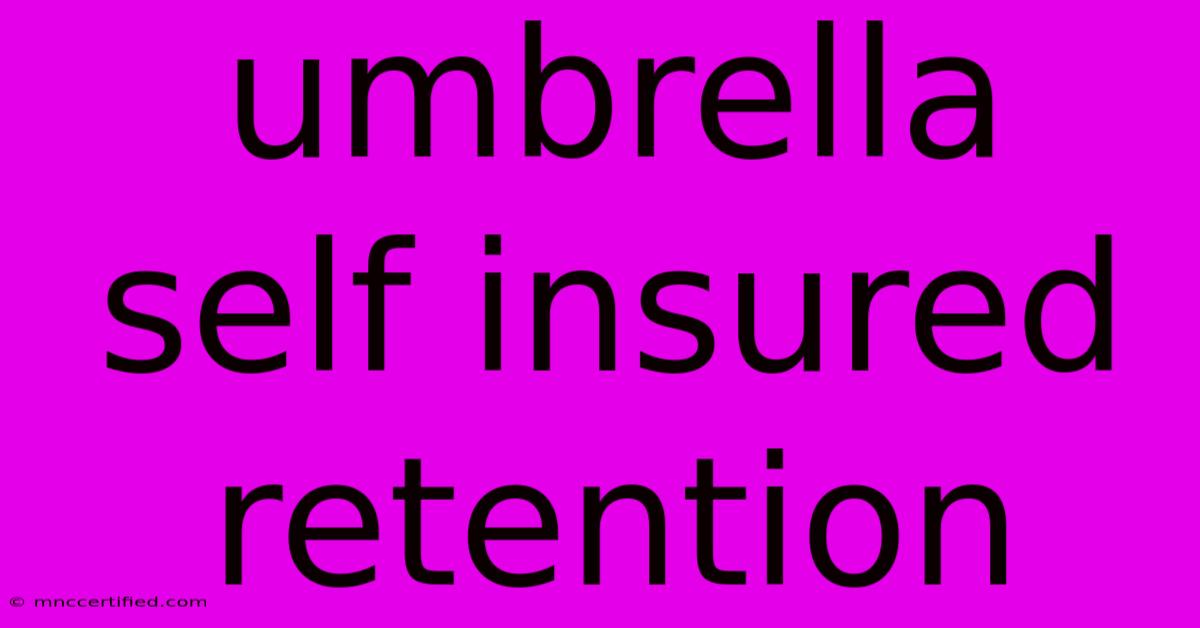Umbrella Self Insured Retention

Table of Contents
Umbrella Self-Insured Retention: A Comprehensive Guide
Understanding self-insured retention (SIR) within the context of an umbrella liability policy is crucial for businesses and high-net-worth individuals seeking comprehensive risk management. This guide will delve into the intricacies of umbrella SIR, explaining its implications, benefits, and potential drawbacks.
What is Umbrella Self-Insured Retention (SIR)?
An umbrella liability insurance policy provides excess liability coverage above the limits of your underlying insurance policies, such as auto, homeowner's, or commercial general liability. However, many umbrella policies include a self-insured retention (SIR), often referred to as a deductible, which represents the amount the policyholder must pay out-of-pocket before the umbrella coverage kicks in. This is the umbrella SIR. This means that if a claim exceeds your underlying policy limits, you'll be responsible for paying the SIR before the umbrella policy starts paying benefits.
Think of it like this: Your underlying insurance policies are your first line of defense. The umbrella policy is your backup, but the SIR is the cost of calling in the backup.
How Umbrella SIR Works
Let's illustrate with an example:
You have a $300,000 liability limit on your auto insurance and a $1 million umbrella policy with a $10,000 SIR. You cause an accident resulting in $1.5 million in damages.
- Underlying Policy Pays: Your auto insurance pays its limit of $300,000.
- SIR is Applied: You are responsible for the $10,000 SIR.
- Umbrella Coverage Kicks In: The remaining $1,190,000 ($1,500,000 - $300,000 - $10,000) is covered by your umbrella policy.
The SIR amount can significantly impact your financial exposure. A higher SIR means lower premiums, but also a greater financial risk. A lower SIR means higher premiums but better protection. The optimal SIR depends on your risk tolerance and financial capacity.
Benefits of a High Umbrella Self-Insured Retention
Choosing a higher SIR can offer several advantages:
- Lower Premiums: A higher retention means you are assuming more risk, leading to lower premiums from the insurance company. This can be particularly attractive for businesses or individuals with strong financial positions.
- Increased Savings: The potential savings from lower premiums can be substantial over the policy's term.
- Greater Control: A higher SIR allows for more control over risk management and potential claims.
Drawbacks of a High Umbrella Self-Insured Retention
However, opting for a high SIR also presents disadvantages:
- Significant Financial Risk: You bear the full financial burden of claims up to the SIR amount. A significant claim could have severe financial consequences.
- Potential for Insolvency: A large claim exceeding the SIR could lead to financial hardship or even insolvency.
- Increased Exposure: The higher your SIR, the greater your exposure to potential financial losses.
Factors to Consider When Choosing an Umbrella SIR
Several factors influence the optimal SIR level:
- Financial Stability: Assess your financial resources and capacity to absorb a significant unexpected expense.
- Risk Tolerance: Determine your comfort level with financial risk. Are you willing to accept a higher potential loss for lower premiums?
- Claim History: Your past claim history can impact your premium and the availability of different SIR options.
- Type of Business: The nature of your business and its inherent risks will influence the appropriate SIR level.
- Professional Advice: Consult with an insurance broker or financial advisor to discuss your specific needs and determine the most appropriate SIR for your circumstances.
Conclusion: Navigating the Umbrella SIR Landscape
Choosing the right umbrella SIR requires careful consideration of your financial resources, risk tolerance, and the potential for significant claims. While a higher SIR can lead to cost savings, it also increases your financial exposure. Thorough assessment and professional guidance are vital to finding the balance that best protects your financial well-being. Remember to regularly review your SIR and insurance coverage to ensure it aligns with your evolving risk profile and financial capacity. Understanding umbrella self-insured retention is key to effective risk management.

Thank you for visiting our website wich cover about Umbrella Self Insured Retention. We hope the information provided has been useful to you. Feel free to contact us if you have any questions or need further assistance. See you next time and dont miss to bookmark.
Featured Posts
-
Matchday Clements Dundee United Xi
Nov 24, 2024
-
Georgia Vs U Mass Final Score Complete Game
Nov 24, 2024
-
Sunderland Millwall Game Stopped Medical Emergency
Nov 24, 2024
-
Arsenal 3 0 Victory Nwaneris League Debut
Nov 24, 2024
-
Shark Fin Cornwall Coast Sighting
Nov 24, 2024